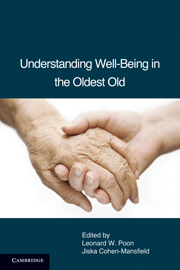Book contents
- Frontmatter
- Contents
- List of Tables
- List of Contributors
- Foreword by Carol D. Ryff
- PART I THEORY: NEW HORIZONS IN WELL-BEING RESEARCH
- 1 Toward New Directions in the Study of Well-Being among the Oldest Old
- 2 From Ageless Self to Selfless Age: Toward a Theoretical Turn in Gerontological Understanding
- 3 The Pursuit of Happiness: Alternative Conceptions of Subjective Well-Being
- 4 The Shifting Baseline Theory of Well-Being: Lessons from across the Aging Spectrum
- 5 The Model of Developmental Adaptation: Implications for Understanding Well-Being in Old-Old Age
- PART II PARADISE LOST: BETWEEN TRAUMA AND HAPPINESS
- PART III PATHWAYS AND GATEKEEPERS: MODERATING, MEDIATING, AND PROXIMAL PROCESSES
- PART IV SIGNPOSTING PARADISE: MEASUREMENT OF WELL-BEING
- Index
- References
3 - The Pursuit of Happiness: Alternative Conceptions of Subjective Well-Being
Published online by Cambridge University Press: 05 August 2012
- Frontmatter
- Contents
- List of Tables
- List of Contributors
- Foreword by Carol D. Ryff
- PART I THEORY: NEW HORIZONS IN WELL-BEING RESEARCH
- 1 Toward New Directions in the Study of Well-Being among the Oldest Old
- 2 From Ageless Self to Selfless Age: Toward a Theoretical Turn in Gerontological Understanding
- 3 The Pursuit of Happiness: Alternative Conceptions of Subjective Well-Being
- 4 The Shifting Baseline Theory of Well-Being: Lessons from across the Aging Spectrum
- 5 The Model of Developmental Adaptation: Implications for Understanding Well-Being in Old-Old Age
- PART II PARADISE LOST: BETWEEN TRAUMA AND HAPPINESS
- PART III PATHWAYS AND GATEKEEPERS: MODERATING, MEDIATING, AND PROXIMAL PROCESSES
- PART IV SIGNPOSTING PARADISE: MEASUREMENT OF WELL-BEING
- Index
- References
Summary
ABSTRACT
This chapter reviews the evolvement of the concept of happiness and its derivative, subjective well-being (SWB), in the research-oriented literature. Happiness and SWB refer to self-evaluations that people make about their general life condition, basically in positive-negative terms. The abundant studies on this topic have not resolved certain puzzles which culminate in the apparent contradiction between two large bodies of empirical research. The first provides evidence that most people are happy whereas the second demonstrates that the bad is stronger than the good in human experiences. Addressing the need to advance an integrative theory in the field, this chapter presents a new conceptual model of the pursuit of happiness in the face of adversity. This model considers SWB as an active agent of adaptation, and explicates its role and activity modules vis-à-vis the hostile-world scenarios of life. The chapter then focuses on the implications of this model for old and old-old age. SWB in advanced age has a vital adaptive value when framed in relation to the particular time perspective of living close to death, as well as to the life story required to account for the long-lived life.
- Type
- Chapter
- Information
- Understanding Well-Being in the Oldest Old , pp. 27 - 45Publisher: Cambridge University PressPrint publication year: 2011
References
- 24
- Cited by

